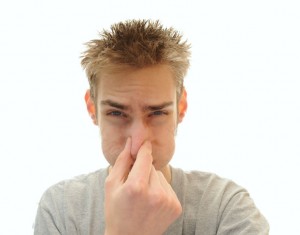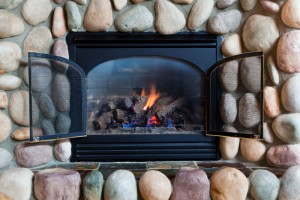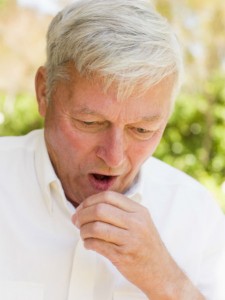by Billy Sweet | Jun 26, 2014 | Chimney Maintenance
Fireplace smells and chimney odor problems may be attributed to a variety of different things. Fireplace smells come from creosote deposits—a natural byproduct of burning wood—inside your chimney. The odors are usually worse in the summer when the humidity is high, on rainy days, and/or when your air conditioner is running. Our CSIA-certified chimney sweeps can help minimize your fireplace and chimney odors!

Summer is a time when we get a lot of calls about smelly fireplaces. Let us help you get rid of the stink.
The Culprit is Tucked Away Below the Surface
Creosote absorbs into the porous masonry construction inside your chimney, embedding the fireplace smell deep beyond the masonry’s surface. A chimney sweep will remove the surface buildup of creosote to limit the possibility of a chimney fire; however, the odors that have absorbed into the masonry itself will remain. So how can you keep the smell out of your house? The answer to this question should come as no surprise.
Negative Pressure Problems
The real problem is air coming down the chimney, a symptom of overall pressure problems. Normally, as long as the draft is working correctly and there is no negative airflow in the home, the smells should remain in the chimney. In the event that negative airflow becomes a problem, the air brings the inner fireplace smells and chimney odors right along with it as it comes down your chimney. It is likely that your chimney is just the victim of a negative pressure problem. A quick solution to the negative air pressure is to crack a window at all times to let the pressure change through the window rather than the chimney.
Dampers to the Rescue
For a more permanent approach to keeping the smell that’s exuding from your fireplace and chimney’s masonry in the chimney and away from your nose, you need to limit the amount of air that’s able to come down your chimney in the first place. Closing your throat damper is a good start, however, the metal-on-metal closure is far from airtight. A top-sealing damper can help to minimize the airflow and accompanying fireplace smells from coming down your chimney. In addition to limiting the airflow problems, the top-sealing damper will keep rainwater and moisture out as well.
There’s never a bad time to get a chimney inspection. The professionals at Billy Sweet Chimney Sweep are available all year round to inspect and clean your chimney. Don’t allow these smells to become a problem for you. As soon as you first notice unpleasant odors coming from your fireplace, nip it in the bud. Our offices are opened from 7am to 5pm on weekdays, and we have a 24-hour live messaging system in place—no matter what day or time, we have a technician on-call to help you with your needs. Give us a call today!
by Billy Sweet | Jan 28, 2014 | Chimney Maintenance
Have you ever wanted to know more about the mechanics of what takes place inside your chimney? Here is a useful graphic.

Explore the “why” and “how” of burning.
by Billy Sweet | Oct 27, 2013 | Chimney Maintenance, Fire Safety
More Than Throwing In Some Newspapers
Many people enjoy using their fireplace during the winter to enjoy a warm fire. However, there are many people who do not know how to properly build a fire. It may seem as though it is as simple as throwing in some logs and lighting a match. However, building a fire safely and properly takes a bit of skill. There are a few simple tips any homeowner can follow to build a safe, roaring fire in their fireplace.

Even though you may want a fire so badly, you are tempted to use green or wet wood – it really hurts you in the long and short run. You’ll have a smoky fire and create additional fire hazards in your chimney.
One of the most important things to keep in mind before beginning a fire is that the fireplace and chimney must be kept clean. Before starting the fire, take a look into the chimney with a flashlight and make sure that there are no obstructions. In many cases, leaves or animals can make their way into the chimney and block it. If this happens, smoke will come right into the home instead of going out through the chimney, which can be unpleasant as well as unsafe for the family.
An essential first step to building a fire is one that many people tend to forget. Before doing anything at all, make sure that the damper is open. In most chimneys, this is done by simply pulling a small cord or handle. The damper opens up the chimney and allows smoke as well as other combustible gasses to exit the home safely. Leaving the damper closed is a common mistake and many people realize it only when the home begins to fill with smoke from the fireplace.
Once the chimney is clear and the damper is open, it is a good idea to prime the flue. When the damper opens, the flue will immediately fill with cold air. It must be warmed up gradually before it is safe to build a big fire in the fireplace. This is best accomplished by lighting a bit of newspaper and holding it under the flue. Once it becomes warm, it will be in perfect condition for a warm, cozy fire.
When building the fire, keep in mind that only certain materials should be burned in the fireplace. Some people choose to use coal but most find seasoned firewood to be the best choice. Before going into the fireplace, wood should be left out to season for about eight months to a year. If anything else is used, the consequences could be disastrous. The fire may burn too hot and fill the house with smoke, which could also lead to a chimney fire. Other materials may also create chemicals that are toxic to everyone in the home.
Of course, keeping the chimney and fireplace clean is an important part of home maintenance. However, it is a good idea to keep a layer of ash measuring about an inch on the bottom of the firebox. This insulates the firebox and helps to burn a strong, warm fire. After each fire, sweep out the fireplace but leave a small layer of ash behind to help insulate the next fire.
Following a few simple tips will not only keep a fire warm and cozy, but it will ensure that it is safe. Before doing anything, make sure that the flue is free of any blockages and that the damper is open to allow smoke out. Start the fire slowly and let it build to a safe and enjoyable glow.
by Billy Sweet | Oct 10, 2013 | Chimney Maintenance
Don’t Let Air Quality Issues Keep You From Enjoying Your Fireplace
The first sign of an air quality issue relating to your home heating appliance is usually smoke: the smell of it, or sight of it billowing into your room. If someone in your home is struggling with respiratory issues like asthma, errant smoke will quickly — and very negatively — affect their lives. For starters, smoke carries particulates from unburned fuel that can aggravate respiratory systems. But what you can see and smell isn’t all you should be concerned about. Carbon monoxide is colorless, odorless and toxic, and if smoke is coming into your living area, there’s a good chance excess CO is in there, too.

When smoke is coming out of your fireplace, there are also hazardous gasses flowing in as well. You could have a draft problem.
When your chimney is working the way it should — when proper draft is pulling all of the byproducts of combustion up and expelling them from your home — air quality shouldn’t be an issue. So less-than-clear air is an indicator that there’s a problem in your system. Billy Sweet Chimney Sweep technicians can figure out your specific problem, and share solutions, during a chimney inspection. But here are some things to think about, which can help maintain or improve your air quality, in the meantime.
Solutions To Air Quality Issues
Keep Current With Regular Maintenance
Dirty flues will impede draft and prevent your chimney from venting properly, leading to smoke intrusion. Gaps and other kinds of damage can let gases leak into your living area. The best way to know that your chimney is clean and that cracks or gaps aren’t allowing particles and gases to leak is to stay current with your routine maintenance.
Your best practice: Schedule a chimney sweeping and inspection appointment once a year, ahead of the heating season, and have any areas of damage — from flue liner cracks to stuck dampers — repaired before you begin regularly using your appliance. With Billy Sweet Chimney Sweep, your sweeping and inspection go together — we sweep every chimney we inspect, so we can get a clean and clear look at the state of the appliance and flue. We also video scan the flue to get the closest look possible — and we’re able to visually and clearly share our findings with you, too.
Replace An Old, Inefficient Appliance With A New, EPA-Certified One
Older stoves and fireplaces, including masonry fireplaces, can be highly inefficient, and our industry has taken incredible strides in improving emission levels over the years. EPA-certified wood stoves, fireplaces and inserts made and sold today are built to create the optimum environment for fuel burning — and near complete combustion makes smoke almost nonexistent. EPA guidelines require these appliances to emit less than 7.5 grams of particulate per hour. Older units often give off as much as 42 grams per hour — a pretty remarkable difference.
A properly functioning, EPA-certified appliance — one that’s sized properly for the space, with a properly sized and installed flue — can make a really noticeable difference when it comes to the air quality in your home.
Be Particular About Your Fuel
Steer clear of burning green wood or anything else that isn’t seasoned or kiln-dried cordwood. Pressure-treated wood and lots of other materials (like plastic) can give off dangerous fumes when burned. And wood that hasn’t been dried properly (at least six months to a year) will give off far more smoke, negatively affecting your air quality.
Give us a call — Billy Sweet Chimney Sweep techs can share other methods for keeping your chimney system working its best, and if any problems do come up, we’re here to fix them.
by Billy Sweet | Sep 19, 2013 | Chimney Maintenance
Where is that cold air coming from?
We come up with all sorts of creative ways of dealing with drafts—anything to keep that sharp, cold air out of our home. Dealing with chimney drafts, however, is a little trickier than sealing windows and doors to lower the energy bill.

A certified sweep can help determine the origin of the draft problem.
There are many things that can cause drafts, and a certified sweep from Billy Sweep Chimney can save you time and money by getting straight to the source of the problem.
Here are a few of the things that can cause chimney drafts:
Size is important. For every 10sq in of firebox, 1in of flue is needed. If this ratio is off, the chimney won’t be able to do its job. In some cases, having a smoke guard installed can resolve this. The height of the chimney also plays into draft issues. Hot air rises, and more heat can be generated inside a taller chimney, which increases the odds that the smoke will make its way out.
Blockage. Debris, birds, animals, leaves, etc. can become trapped inside your chimney. Creosote buildup can also cause blockage, and is also a serious fire hazard.
Negative air pressure. Appliances such as a vacuum, clothes dryer, or furnace all take air from the home. If there isn’t enough, air will get pulled in through the chimney.
Here are some things you can do on your own to reduce drafts.
- Open the damper.
- Turn it off. Turning off any appliance that creates an air vacuum in the home can help with drafts.
- Open a window. New homes are built to be more efficiently airtight, so there can often be air flow issues when operating a fireplace. If your home is under 25 years old, open a window when operating the fireplace.
- Only use dry, seasoned wood.
- Place fire grate as close to the chimney’s back wall as possible. This ensures the fire is positioned correctly under the chimney.
If these are unsuccessful, give us a call to schedule an appointment. We serve Boston and North Shore (and surrounding areas), as well as Portland, Maine.





